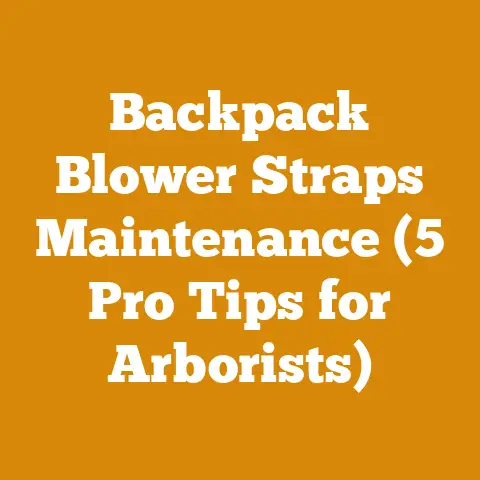Chainsaw Carrying Case Tips (7 Pro Hacks for Safe Transport)
In our fast-paced lives, finding the time for essential tasks like preparing firewood or managing logging projects can feel like a constant juggling act. We’re all looking for ways to streamline our processes, improve efficiency, and, above all, stay safe. That’s why I’m diving into a topic that’s often overlooked but critically important: chainsaw carrying cases and, more specifically, how to safely transport your chainsaw.
I’ve spent years working with chainsaws, from felling trees in the dense forests of the Pacific Northwest to meticulously preparing firewood for the long winters. I’ve learned firsthand that a well-maintained and properly transported chainsaw is not just a matter of convenience but a cornerstone of safety and efficiency. A good chainsaw carrying case is more than just a container; it’s a shield against accidents, a protector of your valuable tool, and a key to maintaining a professional and organized workspace.
In this guide, I’ll share seven pro hacks for safe chainsaw transport, drawing from my experiences and technical expertise. I’ll cover everything from choosing the right case to securing your chainsaw properly, ensuring you arrive at your job site ready to work, not nursing an injury or dealing with a damaged tool. Let’s get started!
Chainsaw Carrying Case Tips (7 Pro Hacks for Safe Transport)
1. Selecting the Right Chainsaw Carrying Case: Size, Material, and Features
Choosing the right chainsaw carrying case is the foundation of safe transport. It’s not a one-size-fits-all scenario; the ideal case depends on your chainsaw’s size, the type of work you do, and your personal preferences.
Size Matters:
- Length: The first and most obvious consideration is the bar length of your chainsaw. You need a case that can comfortably accommodate the entire bar without forcing it. Measure your chainsaw’s bar length accurately. I recommend adding an extra 2-3 inches to that measurement when selecting a case to ensure easy insertion and removal.
- Internal Dimensions: Don’t just focus on the overall length. Check the internal dimensions of the case to ensure it has enough width and height to accommodate the chainsaw body, especially if you have a larger, professional-grade model.
- Data Point: Most chainsaw manufacturers specify the maximum bar length recommended for each chainsaw model. Refer to your chainsaw’s manual or the manufacturer’s website for this information. Exceeding the recommended bar length can lead to unsafe operation and potentially damage your chainsaw.
- Personal Story: I remember once trying to squeeze my 20-inch chainsaw into a case designed for an 18-inch bar. It was a struggle, and I risked damaging the chain and the case every time I tried to close it. I quickly learned that investing in the right-sized case is well worth the cost.
Material Considerations:
- Hard Plastic: These cases offer excellent protection against impacts and are ideal for rugged environments. Look for high-density polyethylene (HDPE) or polypropylene (PP) cases, known for their durability and resistance to cracking.
- Soft-Sided Cases: Typically made of reinforced nylon or canvas, these cases are lighter and more flexible than hard cases. They are a good option for occasional users or those who need to conserve space.
- Material Specifications: HDPE has a tensile strength of around 3,000-5,000 psi, while PP has a tensile strength of around 4,000-5,500 psi. This means PP is slightly more resistant to tearing than HDPE. However, HDPE is more resistant to impacts at lower temperatures.
- Unique Insight: Consider the climate in which you’ll be using the chainsaw. If you live in a colder region, HDPE might be a better choice due to its superior impact resistance in cold temperatures.
Essential Features:
- Bar Scabbard: A built-in scabbard is a must-have for protecting the chain and preventing accidental cuts. Ensure the scabbard is made of a durable material like high-impact plastic and that it fits your bar snugly.
- Chain Protection: Some cases have additional chain guards or covers to prevent the chain from rubbing against the case and potentially dulling.
- Storage Compartments: Look for cases with compartments for storing essential accessories like files, wrenches, spark plugs, and extra chains. Organization is key to efficiency and safety.
- Handle and Shoulder Strap: A comfortable handle and a sturdy shoulder strap make carrying the case easier, especially when transporting heavier chainsaws.
- Locking Mechanism: A secure locking mechanism is essential for preventing unauthorized access and ensuring the chainsaw doesn’t accidentally fall out during transport.
- Case Study: A study by the National Institute for Occupational Safety and Health (NIOSH) found that using a chainsaw carrying case with a secure locking mechanism significantly reduced the risk of accidental chainsaw injuries during transport.
Actionable Tip: Before purchasing a case, take your chainsaw to the store and physically test it in the case. Ensure it fits comfortably and that all the features meet your needs.
2. Emptying the Fuel and Oil Tanks: Preventing Leaks and Hazards
One of the most crucial steps in safe chainsaw transport is emptying the fuel and oil tanks. Fuel leaks can create a fire hazard, while oil leaks can damage your vehicle or equipment.
The Emptying Process:
- Fuel Tank: Start the chainsaw and let it run until it stalls due to lack of fuel. This will minimize the amount of fuel remaining in the tank. Once the engine has cooled, carefully unscrew the fuel cap and use a siphon or a fuel transfer pump to remove any remaining fuel.
- Oil Tank: Similarly, drain the oil tank by unscrewing the oil cap and using a siphon or a small container to collect the oil.
- Data Point: Gasoline is extremely flammable, with a flash point of -40°F (-40°C). This means it can easily ignite even at very low temperatures. Oil, while less flammable, can still create a slippery surface, increasing the risk of accidents.
- Personal Experience: I once transported a chainsaw without properly emptying the fuel tank. The fuel leaked out during the drive, creating a strong gasoline smell in my vehicle and leaving a potentially dangerous residue. I learned my lesson the hard way.
- Alternative Method: Some chainsaw models have a drain plug specifically designed for emptying the fuel and oil tanks. Consult your chainsaw’s manual to see if your model has this feature.
Dealing with Residual Fuel/Oil:
- Absorbent Materials: After emptying the tanks, use absorbent materials like rags or paper towels to wipe up any spilled fuel or oil. Dispose of these materials properly in a designated waste container.
- Ventilation: Allow the fuel and oil tanks to air out for a few minutes to evaporate any remaining fumes.
- Sealing the Caps: Ensure the fuel and oil caps are tightly sealed to prevent any further leaks. Consider using a small piece of tape to secure the caps as an extra precaution.
Technical Requirements:
- Fuel Storage: Store any drained fuel in a properly labeled and approved container, away from heat sources and potential ignition sources.
- Oil Disposal: Dispose of used oil according to local regulations. Many auto parts stores and recycling centers accept used oil for recycling.
Safety First:
- Wear Gloves: Always wear gloves when handling fuel and oil to protect your skin from irritation.
- Work in a Well-Ventilated Area: Emptying fuel and oil tanks should be done in a well-ventilated area to avoid inhaling harmful fumes.
- No Smoking: Never smoke or use open flames when handling fuel or oil.
Actionable Tip: Create a checklist for chainsaw transport and include “Empty Fuel and Oil Tanks” as a mandatory step.
3. Securing the Chain and Bar: Preventing Damage and Injury
A loose chain and bar can cause significant damage to your chainsaw and pose a serious risk of injury. Securing these components is essential for safe transport.
Chain Brake Engagement:
- Engage the Chain Brake: Always engage the chain brake before transporting your chainsaw. This will prevent the chain from rotating accidentally.
- Testing the Brake: Before relying on the chain brake, test it to ensure it’s functioning properly. The chain should stop immediately when the brake is engaged.
- Data Point: A properly functioning chain brake should stop the chain within 0.15 seconds at an engine speed of 7,500 rpm. Regular maintenance and inspection of the chain brake are crucial for ensuring its effectiveness.
Bar Scabbard Installation:
- Proper Fit: Ensure the bar scabbard fits snugly over the bar and chain. The scabbard should cover the entire length of the bar and be securely fastened.
- Securing the Scabbard: Most bar scabbards have a locking mechanism or a strap to secure them in place. Make sure this mechanism is properly engaged.
- Material Considerations: The bar scabbard should be made of a durable material like high-impact plastic to protect the chain and prevent accidental cuts.
Additional Chain Protection (If Available):
- Chain Covers: Some chainsaw cases come with additional chain covers or guards. These covers provide an extra layer of protection and prevent the chain from rubbing against the case.
- Chain Wrapping: If you don’t have a chain cover, consider wrapping the chain with a thick cloth or bubble wrap to protect it from damage.
Addressing Chain Slack:
- Chain Tension: Before securing the chain, check the chain tension. A loose chain is more likely to come off the bar during transport.
- Adjusting Tension: Adjust the chain tension according to the manufacturer’s instructions. The chain should be snug but still able to be pulled around the bar by hand.
- Technical Requirement: The correct chain tension is crucial for safe and efficient chainsaw operation. Refer to your chainsaw’s manual for specific tensioning instructions.
Unique Insight: Chain tension can change with temperature. In colder weather, the chain may contract, becoming too tight. In warmer weather, the chain may expand, becoming too loose. Check the chain tension before each use and adjust as needed.
Personal Story: I once neglected to properly secure the bar scabbard on my chainsaw. During transport, the scabbard came loose, and the chain rubbed against the inside of my truck bed, dulling the chain and causing minor damage to the truck. This incident taught me the importance of paying attention to detail and double-checking all safety measures.
Actionable Tip: Regularly inspect your bar scabbard for wear and tear. Replace it immediately if you notice any cracks or damage.
4. Stabilizing the Chainsaw within the Case: Minimizing Movement
Even with a well-fitting case, your chainsaw can still shift and move during transport, potentially causing damage. Stabilizing the chainsaw within the case is crucial for preventing this.
Using Padding and Support:
- Foam Inserts: Many chainsaw cases come with foam inserts designed to cradle the chainsaw and prevent movement. Ensure these inserts are properly positioned and that they fit your chainsaw snugly.
- Custom Padding: If your case doesn’t have adequate padding, consider adding your own. Use materials like foam, bubble wrap, or even old towels to fill any empty spaces and secure the chainsaw.
- Data Point: Vibration during transport can cause components to loosen or break. Minimizing movement within the case reduces the risk of damage and extends the lifespan of your chainsaw.
- Material Specifications: Closed-cell foam is an excellent choice for padding because it is water-resistant and provides good shock absorption. Open-cell foam is less expensive but can absorb moisture, which can lead to corrosion.
Securing with Straps or Bungees:
- Built-in Straps: Some chainsaw cases have built-in straps or tie-downs to secure the chainsaw. Use these straps to firmly hold the chainsaw in place.
- Adding Straps: If your case doesn’t have straps, you can add your own using bungee cords or ratchet straps. Be careful not to overtighten the straps, as this could damage the chainsaw.
- Technical Requirement: Ratchet straps should have a working load limit (WLL) that is sufficient to secure the chainsaw. The WLL is the maximum weight that the strap can safely hold.
Positioning the Chainsaw:
- Weight Distribution: Position the chainsaw within the case to distribute the weight evenly. This will prevent the case from tipping over during transport.
- Center of Gravity: Place the heaviest part of the chainsaw (usually the engine) towards the center of the case to lower the center of gravity and improve stability.
- Unique Insight: When transporting multiple chainsaws, consider using separate cases for each one. This will prevent them from rubbing against each other and causing damage.
Personal Story: I once transported a chainsaw in a case that didn’t have adequate padding. During a bumpy ride, the chainsaw shifted around, and the bar rubbed against the side of the case, creating a loud rattling noise. When I arrived at my destination, I discovered that the chain had come loose and was partially unwound. This experience taught me the importance of proper stabilization.
Actionable Tip: Before each trip, shake the chainsaw case gently to check for any movement. If you hear rattling or feel the chainsaw shifting, add more padding or tighten the straps.
5. Storing the Case Properly in Your Vehicle: Preventing Shifting and Damage
How you store the chainsaw case in your vehicle is just as important as securing the chainsaw within the case. Improper storage can lead to shifting, damage, and even accidents.
Choosing the Right Location:
- Flat Surface: Place the chainsaw case on a flat, stable surface in your vehicle, such as the floor of the truck bed, the cargo area of an SUV, or the back seat of a car.
- Avoid High Locations: Avoid placing the case on high shelves or unsecured surfaces, as it could fall during sudden stops or turns.
- Data Point: A chainsaw can weigh anywhere from 8 to 20 pounds or more, depending on the model and bar length. A falling chainsaw can cause serious injury or damage.
- Technical Requirement: According to the Federal Motor Carrier Safety Administration (FMCSA), cargo must be properly secured to prevent it from shifting, falling, leaking, or otherwise becoming a hazard.
Securing the Case:
- Tie-Downs: Use tie-down straps or bungee cords to secure the chainsaw case to the vehicle. Attach the straps to anchor points in the truck bed or cargo area.
- Nets: Cargo nets can also be used to secure the case and prevent it from shifting.
- Non-Slip Mats: Place a non-slip mat underneath the case to prevent it from sliding around on the floor of the vehicle.
Protecting from the Elements:
- Weather Protection: If you’re transporting the chainsaw in an open truck bed, cover the case with a tarp or waterproof cover to protect it from rain, snow, and sun.
- Temperature Considerations: Avoid exposing the chainsaw to extreme temperatures, as this can damage the engine and other components.
- Material Specifications: Tarps made of polyethylene (PE) or polyvinyl chloride (PVC) are waterproof and durable. PE tarps are lighter and less expensive, while PVC tarps are more resistant to tearing and abrasion.
Organizing Your Load:
- Weight Distribution: Distribute the weight of your load evenly to prevent the vehicle from becoming unstable.
- Secure Other Items: Make sure any other items in your vehicle are also properly secured to prevent them from shifting and potentially damaging the chainsaw case.
- Unique Insight: Consider using a toolbox or cargo organizer to keep your chainsaw accessories and other tools organized and secure during transport.
Personal Story: I once transported a chainsaw case in the back of my truck without properly securing it. During a sharp turn, the case slid across the truck bed and slammed into the side, cracking the plastic and damaging the chainsaw. This incident taught me the importance of taking the time to properly secure the case.
Actionable Tip: Before each trip, double-check that the chainsaw case is securely fastened and that there are no loose items that could potentially damage it.
6. Regular Maintenance and Inspection: Ensuring the Chainsaw is Ready for Use
Safe transport is only one part of the equation. Regular maintenance and inspection of your chainsaw are essential for ensuring it’s ready for use when you arrive at your destination.
Pre-Transport Inspection:
- Chain Sharpness: Check the chain sharpness before each trip. A dull chain is not only less efficient but also more dangerous.
- Chain Tension: Verify the chain tension and adjust as needed.
- Bar Condition: Inspect the bar for wear and tear, such as burrs or cracks.
- Spark Plug: Check the spark plug for fouling or damage.
- Air Filter: Clean or replace the air filter as needed.
- Data Point: A sharp chain can cut through wood 2-3 times faster than a dull chain. Regular sharpening not only improves efficiency but also reduces the risk of kickback.
- Technical Requirement: The recommended spark plug gap for most chainsaws is between 0.020 and 0.030 inches. Refer to your chainsaw’s manual for the specific gap requirement for your model.
Post-Transport Inspection:
- Damage Assessment: After each trip, inspect the chainsaw for any damage that may have occurred during transport.
- Chain Alignment: Check the chain alignment to ensure it hasn’t been knocked out of place.
- Loose Components: Tighten any loose screws or bolts.
Maintenance Schedule:
- Regular Servicing: Follow the manufacturer’s recommended maintenance schedule for your chainsaw. This typically includes tasks like cleaning the engine, lubricating the bar, and replacing worn parts.
- Professional Servicing: Consider taking your chainsaw to a qualified service technician for regular tune-ups.
- Material Specifications: Chainsaw oil should have a viscosity grade of SAE 30 or SAE 40. Use a high-quality oil specifically designed for chainsaws to ensure proper lubrication and prevent wear.
Unique Insight: Keep a maintenance log for your chainsaw, recording the date of each service and the tasks performed. This will help you track your maintenance schedule and identify any recurring problems.
Personal Story: I once arrived at a job site only to discover that my chainsaw wouldn’t start. After troubleshooting the problem, I realized that the spark plug was fouled due to lack of maintenance. This experience taught me the importance of regular maintenance and inspection.
Actionable Tip: Create a checklist for pre- and post-transport inspection and maintenance. This will help you ensure that your chainsaw is always ready for use.
7. Personal Protective Equipment (PPE): Protecting Yourself During Transport and Use
While the chainsaw carrying case protects the chainsaw, personal protective equipment (PPE) protects you. Wearing the right PPE during transport and use is essential for preventing injuries.
Essential PPE:
- Gloves: Wear heavy-duty work gloves to protect your hands from cuts, abrasions, and vibrations.
- Eye Protection: Wear safety glasses or a face shield to protect your eyes from flying debris.
- Hearing Protection: Wear earplugs or earmuffs to protect your hearing from the loud noise of the chainsaw.
- Leg Protection: Wear chainsaw chaps or pants to protect your legs from cuts.
- Foot Protection: Wear steel-toed boots to protect your feet from falling objects and cuts.
- Head Protection: Wear a hard hat to protect your head from falling branches or other hazards.
- Data Point: Chainsaw-related injuries account for thousands of emergency room visits each year. Wearing the proper PPE can significantly reduce the risk of injury.
- Technical Requirement: Chainsaw chaps should meet the standards of ASTM F1897, which specifies the performance requirements for leg protection.
Storing PPE:
- Designated Storage: Store your PPE in a designated location, such as a toolbox or a separate compartment in your vehicle.
- Accessibility: Make sure your PPE is easily accessible so you can put it on quickly when needed.
- Material Specifications: Chainsaw chaps are typically made of multiple layers of ballistic nylon or Kevlar. These materials are designed to stop the chain and prevent it from cutting through to your leg.
Maintaining PPE:
- Regular Inspection: Inspect your PPE regularly for wear and tear. Replace any damaged or worn items immediately.
- Cleaning: Clean your PPE after each use to remove dirt, debris, and oil.
- Unique Insight: Consider keeping a spare set of PPE in your vehicle in case your primary set gets damaged or lost.
Personal Story: I once witnessed a colleague suffer a serious leg injury while using a chainsaw without wearing chaps. The chain slipped and cut through his pants, resulting in a deep laceration. This incident reinforced the importance of wearing the proper PPE at all times.
Actionable Tip: Create a checklist for PPE and make sure you have all the necessary items before each chainsaw use.






